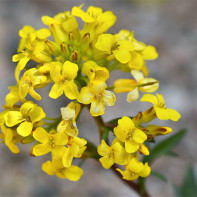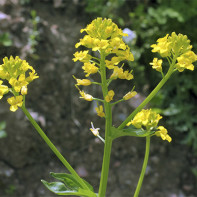Colza: useful properties and contraindications
Undoubtedly, everyone saw the colza, just not everyone knows the correct name of this plain-looking plant. And few people have information about its beneficial qualities and healing abilities.
- Chemical composition
- How it looks and where it grows
- Kinds
- Collection and storage
- The healing properties of colza grass
- For women
- For men
- During pregnancy
- When breastfeeding
- For kids
- Colza in traditional medicine
- From male infertility
- With prostatitis
- With erectile dysfunction
- For the treatment of sexual dysfunction in men
- Juice for Men's Health
- Cooking Application
- Colza Salad
- Colza Salad with Avocado
- Fritters with colza
- Herbal Rolls
- Cake with colza
- Puree puree
- Fried fish with mash of colza
- Types of healing compounds
- Infusion
- Tincture
- Tea
- Useful properties of colza oil
- Can rabbits be given colza
- Contraindications
Chemical composition
The chemical composition of colza gives the right to talk about it as an amazing and unique plant, combining a whole range of components - both useful and those that must be treated with caution.
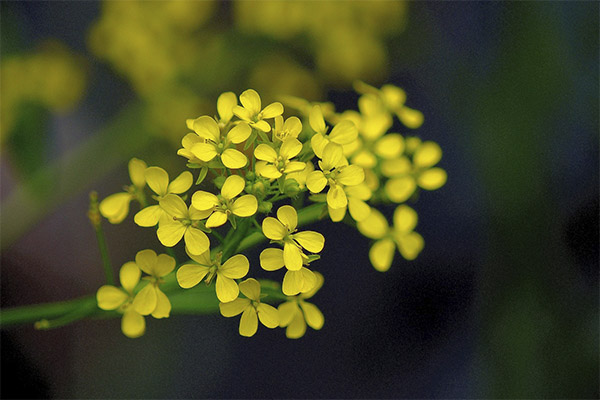
Among the useful ones are flavonoids, famous for their antioxidant properties, capable of neutralizing free radicals, which have a wide range of effects of saponins and glycosides. Thioglycosides can also cause diarrhea. The leaves of the plant are valuable in the content of ascorbic acid.
Seeds comprise more than a third of fatty oils, but they also contain toxic substances, and also contains erucic acid, which can accumulate in the body with prolonged use.
Without organic acids and B vitamins, the picture of the chemical composition would be incomplete, these components of colic are necessary for the trouble-free operation of the heart, nervous system and maintaining the normal emotional state of a person.
How it looks and where it grows
In late spring, on the roadsides, fields, gardens, meadows, on the banks of rivers, lakes and ponds and in parks, one can already see a plant strewn with small yellow flower stars, resembling a bush with a high stem. It is found bare or with a light fluff, with medium-sized leaves and covered with small yellow flowers. This colza is a weed that grows around the world - from Europe to North America, from Africa to Australia and New Zealand. In Russia, colza is hosted everywhere - from the western European borders to Siberia.
Surepka - a representative of the Cabbage (Cruciferous) family, belongs to the rooted perennials: that is, each plant from one season to another resumes its development on a single primary root grown from seed. Over the years, the root grows deeper and deeper into the soil, and each spring a new young shoot appears on it again and again, capable of blooming and multiplying.
Leaves of colza of two types. Some go straight from the root, on the petioles, they are carved, with large lobes of an oval-oblong shape on the sides and a large middle. The upper leaves have denticles along the edge, without petioles, sessile, as if they hug the stem.
The inflorescence of colza is a brush of bisexual flowers of pure sunny color. Their petals are slightly longer than 5 mm long and surround stamens with bright yellow pollen. After flowering is complete, a pod begins to develop on the colza, and gray-brownish oval seeds with a fine-tuberous surface ripen in it.
The plant is so prolific that it can give life to 10 thousand seeds. Ripened seeds scatter quite far from the mother plant - 3 meters or more. The next year, a new plant grows from them, which is not yet capable of propagation: seeds on it will appear only in the second year, and after the end of the first year a strong, developed root will winter in the soil.
Germination requires a temperature of at least 6–8 degrees, and if the heat in the street is above 38–40 degrees, the seeds are also not capable of germination.Seeds hatch quickly - they are capable of this in spring, and autumn, and in summer.
Not only sunny, well-lit places are suitable for the growth of colza, it is quite capable of existing comfortably and giving offspring and in partial shade. The height of the plant, depending on the place and conditions of growth, can vary from 30 to 80 cm. It is favorable to stalks both to meadows or forest glades, to bushes, humid places around ponds, near rivers or other bodies of water, it normally feels near roads, ditches piles of trash.
Since shoots of colza appear early in the spring, at the beginning of summer, plants already throw out seeds that actively penetrate the fields. They thoroughly clog cultural crops, especially on clay soils, which are not very susceptible to mechanized processing. Moreover, not all herbicides are able to overcome this weed.
Kinds
About 20 types of colza are found in nature, but only 4 are the most common. They are wild, stone, arcuate and common.
- Common colza is high - under 80 cm, with a smooth straight stem, blooms in May and June.
- Wild colza looks similar to ordinary, differs only in the stem - branched and covered with hairs. A long period blooms - from May to November, the pods ripen by the end of summer. In addition to substances common to all types of colza, the wild is rich in barium, magnesium, nickel and zinc.
- The arcuate got its name because of the pods, which have a curved arcuate shape. She is the most hygrophilous of all coli, so most often she can be found around ponds. It blooms before its relatives - in April-May.
- Kamennaya differs from its relatives in small growth - only 20-30 cm and slightly later flowering, which begins in June and lasts until October. It is this type of colza as the most decorative that can be seen on the flower beds: some gardeners use it as a background plant.
Collection and storage
In order to properly prepare the colza and get really high-quality medicinal raw materials from it, we must remember: the plant needs to be dried so that sunlight does not fall on it. The best places to dry are a porch, gazebo or attic, where you can arrange a draft. Dried colza does not need to be stored for more than a year. A paper bag or plywood box is perfect — the grass in them will “breathe” and will not lose its value ahead of time.
You need to stock up on grass from mid-May. At this time, the colza is covered with flowers, they are cut along with the stems and leaves, not forgetting the lower leaves coming from the root. Then it is sorted to throw away everything that is torn, eaten by insects or darkened, and sent for drying. Leaves and inflorescences are already separated from dry plants.
They don’t start harvesting the roots before the fall, since near the end of the season they accumulate the maximum amount of nutrients. Older plants with a large large root are chosen, they are more useful. The dug root is washed under running water, wiped with a paper towel and put in the shade for drying - so that a fresh breeze blows it.
It is time to harvest the seeds in July, they are collected still green, and then dried - but not in the sun, while providing an influx of fresh air so that the seeds do not mold. You need to store them directly in the pods, where to get them, when and how much is needed.
The healing properties of colza grass
Each part of colza is rich in various degrees of active substance, this is the reason why, for the treatment of some ailments, for example, leaves are used, others are the root.
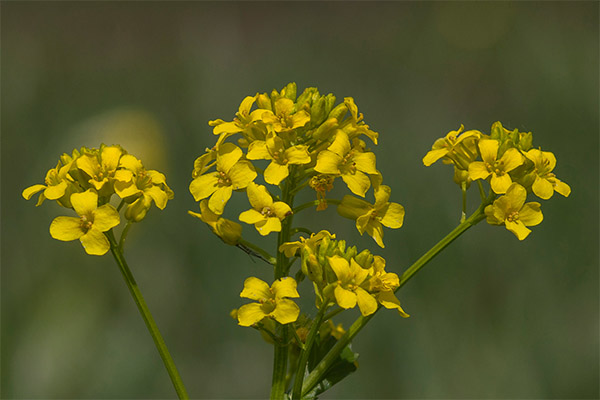
So, in the root, the main violin is played by flavonoids, their action is a diuretic and a mild laxative. The mechanism of action of these substances is as follows: they bring blood vessels into a normal state, as a result of which the lumen expands. As a result, a larger amount of urine is formed. And the consequence of this is a decrease in edema and the effect of detoxification. In addition, anti-fungal and antibacterial properties are characteristic of colza root.
During the photosynthesis, many vitamins accumulate in the leaves, including ascorbic acid, organic acids, and various trace elements. They are responsible for the regulation of acidity in the human body. Their "duty" is also to put in order digestion, increase the acidity of gastric juice, normalize the amount of cholesterol and sugar in the blood.
Due to vitamins, primarily ascorbic acid, leaves are an excellent tonic and immunostimulating agent. The plant can be used as a prevention of scurvy, and salads with young leaves of colza in early spring enrich the body with vitamins.
In the chemical composition of inflorescences, as in other parts of plants, a sufficient amount of flavonoids, vitamins, trace elements, organic acids, glycosides. Flowers can be used as a diuretic and restorative. A characteristic feature of inflorescences is that they have an increased concentration of B vitamins, which can become the basis for the normalization of the nervous system.
There are many thioglycosides in the seeds, which, due to their mild irritating effect, can increase appetite and improve digestion by stimulating the secretion of digestive juices.
For women
With various female hormonal disorders and pathologies, colza has a positive effect. And it is proved in practice. If mastopathy, myoma or inflammatory process is diagnosed, colza will be a good tool in the treatment of the disease.
For men
Colza has not yet been recognized as an official medicine, however, traditional healers and urologists recommend its healing infusions, tinctures and decoctions just to improve the health of the male genital area. Impotence, the need to improve the quality and quantity of seminal fluid, exacerbation of prostatitis - these are the cases when colza is required. In addition, this medicinal plant can improve the production of male sex hormones and eliminate hormonal imbalances.
Thanks to the strengthening of the walls of blood vessels and the improvement of blood flow, which provides colitis, it is possible to solve the problem of treatment of erectile dysfunction. Tea from the leaves of the plant, which fights the effects of stress, adverse environmental conditions, malnutrition, which have a negative impact on men's health, will help in this matter.
The active substance quercetin, located in colza, acts as an antibiotic and fights against pathogenic bacteria that disrupt spermatogenesis.
However, one should not hope that male problems can be cured only by colic. It is necessary to combine the administration of colza-based formulations with the treatment prescribed by the doctor. Remember: a doctor’s consultation is required!
During pregnancy
Many pregnant women, trying not to harm their unborn baby, try to avoid taking pharmacy medicines and replace them with natural counterparts. So, for example, learning about the property of colza to remove swelling, they try to apply healing tinctures from this herb. But do not do this. Indeed, there are many different substances in the colza, and it is impossible to predict in advance what effect each of them will have on an unborn child. It is possible that the baby has an individual intolerance to any of the components of the grass.
When breastfeeding
Mothers who are breast-feeding a baby should also not be in a hurry with taking teas, tinctures or decoctions of colza. Its active substances can pass into breast milk and cause an allergic reaction in the baby - a rash on the skin is quite possible.Diarrhea is not excluded because of the ability of colza to have a laxative effect.
For kids
Do not rush to give babies up to three years old colza, because in its composition there are substances that can cause allergies. From the age of three (and preferably even from the age of five), you can try to introduce greens into salads, give fish, stewed or fried with colza. There are a lot of vitamins in it, leaflets of colza in May are especially valuable.
Colza in traditional medicine
Despite the fact that colza is considered a weed, you can not treat it scornfully: it has many useful properties. Firstly, she is a wonderful honey plant, from which bees collect the first spring nectar. Honey collected from colza contains an increased amount of glucose; it is yellowish-green in color with a pleasant but weak aroma. Thanks to useful substances, the plant is in demand in traditional medicine. Drugs made on the basis of recipes from the ancient books of healers are good preventive agents against the development of age-related diseases, have a cleansing effect on the body and a good therapeutic effect for various male ailments.
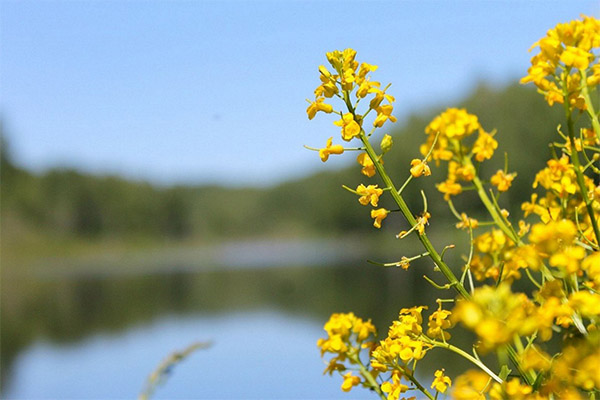
From male infertility
In infertility, caused by lack of mobility and sperm mutations, such a remedy is effective. Pour three tablespoons of dry shredded colza into a bottle of vodka. Insist for two weeks, shaking from time to time. Then strain and consume on an empty stomach three times a day - at least half, but not more than a tablespoon at a time.
With prostatitis
Break the freshly picked leaves and stalks of colza in a blender or scroll in a meat grinder. Squeeze the juice from the resulting slurry. Drink it for two months - daily before meals 4 times in half a tablespoon.
With erectile dysfunction
Take in equal proportions the dried leaves of such herbs: nettle, plantain, St. John's wort, sage, colza, mix and chop them, measure 10 g, pour 200 ml of boiling water, cover with something warm and wait for cooling. Three weeks to drink in the mornings and evenings before meals.
For the treatment of sexual dysfunction in men
Grind the dried root of the plant to a powder state. Take it 0.5 g twice a week with water. A positive result will be noticeable in three weeks.
Juice for Men's Health
To improve the quality of male seed, colza juice is suitable. To get it, you need to scroll in the meat grinder any aerial parts of the plant, and then squeeze the juice through cheesecloth. At least two months 3 times a day after meals to drink 50 ml of juice.
Cooking Application
Colza vulgaris is a rather frequent guest on the dining table, especially often it is used for cooking by residents of America and Canada. This plant perfectly complements many dishes, adding a little piquant sharpness, very similar to a light mustard flavor with a hint of nutty flavor. For culinary purposes, young leaves or flowers that have not yet blossomed are suitable. Japanese prepare inflorescences as a side dish. The simplest dishes are salads.
So that the leaves of colza do not bitter, before cooking salads, they need to be boiled a little, but no longer than three minutes, since with longer contact with boiling water they become tasteless. After this procedure, bitterness is not felt at all, only a slight nutty aftertaste remains.
Colza Salad
Take a handful of chopped leaves of colza and green onions, add two chopped chicken eggs to this mass, salt, mix and season with mayonnaise or sour cream.
Colza Salad with Avocado
Cut the flesh of one avocado into small cubes, add the diced chicken egg, chop 30 g of onion and 100 g of young leaves of colza.Salt, add spices, black pepper and nutmeg are suitable here, pour over with vegetable oil and mix.
Fritters with colza
Finely chop about 100 g of washed and dried inflorescences of colza and a small bulb. Rub one medium potato on a fine grater. Stir potato gruel with onion and colza. Add one chicken egg, two tablespoons of flour, salt to taste and pepper. Mix well. Spread the resulting dough with a spoon on a hot pan and fry on both sides. Serve better with sour cream.
Herbal Rolls
The washed young and tender zucchini cut lengthwise into thin slices. Salt and put in the refrigerator for two to three hours, after such a procedure it will become more elastic. Grind clean leaves of colza (approximately 60 g) and two peeled garlic cloves in a blender. Add the garlic-colza mass to 150 g of cottage cheese, put a handful of walnuts chopped with a knife, as well as thyme and caraway seeds there. Stir the resulting mixture well. If it turns out a little dry, pour in a little milk - about a tablespoon, mix again. Spread on the plates from the zucchini, twist the rolls and rolls ready to remove for a couple of hours in the refrigerator.
Cake with colza
Break three eggs into a bowl, pour 250 ml of kefir, add a teaspoon of salt and soda. Then, with constant stirring, gradually pour 350 g of flour and a teaspoon of soda. Mix the resulting mass thoroughly so that the dough is homogeneous.
Take 300 g of mushrooms (you can bring it from the forest, you can buy mushrooms), soak so that all the dirt goes away, rinse, cut into small slices. Boil 200 g of rice.
Cover the mold with baking paper, put mushrooms on it in one layer. On top of the mushrooms, put a second layer of 300 g of grated cheese. Lay out rice in a third layer. The fourth layer will be from onion: for this medium-sized onion peel and finely chop. For the fifth layer, cut 300 g of washed colza inflorescences.
Gently pour dough on top and spread it evenly over the entire surface. Put the mold in the oven, preheated to 180 degrees. The approximate baking time is 45 minutes.
Puree puree
Cut a medium-sized onion, grate a small carrot on a fine grater, add 200 g of chopped leaves. Put everything in a pan and simmer with sunflower oil until the vegetables reach a puree-like appearance. The side dish is ready!
Fried fish with mash of colza
Dry 400 g of washed cod fillet with a paper towel, salt, sprinkle with dry ground ginger, black pepper. Coat each piece on all sides with mashed potatoes made of colza. Then roll the fish in flour and fry in vegetable oil with the lid open. 5 minutes before cooking, put onion cut in half rings and cover with a lid.
Types of healing compounds
For the preparation of healing infusions and decoctions of colza, any parts of the plant are suitable, you just need to rinse the greens first. It is important to remember: it is impossible to abuse the intake of life-giving compounds, before prescribing treatment yourself, it is better to consult a doctor.

Infusion
Infusion for men. You can use colza to relieve symptoms of prostatitis. For therapeutic infusion, you need a tablespoon of dry chopped leaves, they need to be poured with boiling water (250 ml). Then tightly tighten the lid and insist about 2-3 hours. Drink from one and a half to two tablespoons 3-4 times a day for half an hour before meals. The full course is about two months.
Tincture
- Tincture for the treatment of female problems. If a woman has fibroids, mastopathy, or hormonal failure, you need dried leaves of colza. Heat 1 liter of water to a boil in a dousing ladle, pour two tablespoons of grass there, reduce heat to a minimum and boil for another 20 minutes.Pour the hot composition into the jar, close it tightly with a lid and insist for at least 2 hours. Then strain it with a strainer and drink 4 tablespoons a day and a half tablespoons, a full course - three months.
- Tincture for the treatment of neurotic problems. Not only with neurosis, epilepsy, but also with edema, you can take this recommendation. Heat 1 liter of water to a boil, pour four tablespoons of dry leaves of colza and boil for another half hour. Remove from heat, strain and dilute with clean boiled water to get 1 liter of solution. Insist for 6 to 8 hours under a tightly closed lid. Drink half an hour before meals, take one and a half tablespoons. The course is two weeks.
- Tincture to eliminate urination problems. With urinary delays, accompanied by severe pain, the aerial part of the colza is necessary - both leaves and stems are suitable. Tincture is made of them, for which 20 g of chopped herbs is poured with a small glass of boiling water (200 ml) and closed with a tight lid. The tincture will be ready in 2 hours. They drink it three times a day after meals, a one-time norm is one and a half tablespoons.
Tea
Low Pressure Tea. If the pressure rises, tea from dried colza greens will help. It will not only lead to normal numbers on the tonometer, but also will increase strength. To do this, two tablespoons of dried grass are poured into 300 ml of boiling water, kept on fire for another 10 minutes and left to brew for half an hour. A cup of such tea is drunk in the morning, at lunch and in the evening.
Useful properties of colza oil
Cassava oil is pressed from the seeds of the plant. The active ingredients of the oil make it unique. The product is valued for its ability to positively affect the cardiovascular system, blood flow, lower cholesterol and normalize metabolism. Vitamins E and K, coenzyme Q10, lecithin and phytosterols contained in the oil are “responsible" for this.
Compared to other vegetable oils, coli contains less saturated fats and more omega-3 fatty acids, which are necessary for all people, and especially for residents of megacities.
But so far, colza oil has little use in cooking, because one of its components - erucic acid - is still poorly understood. It is known that with gradual accumulation in the body, it is able to negatively affect the cardiovascular system, inhibit growth and delay the onset of reproductive maturity. Therefore, for constant use, oil is undesirable. But for course receptions it’s even very useful - as a means of preventing obesity and atherosclerosis. It will support the work of the heart, blood vessels, muscles and nervous system, improve the condition of the skin and hair, raise the general tone of the body, help recover after heavy physical exertion and even increase attention.
Can rabbits be given colza
Each rabbit breeder knows how meticulously it is necessary to relate to the nutrition of eared animals. Not all plants and herbs are suitable for feeding both farm rabbits and ornamental ones. These animals are characterized by fragile health, so they can easily not only get a serious upset gastrointestinal tract, but even poison themselves to death.
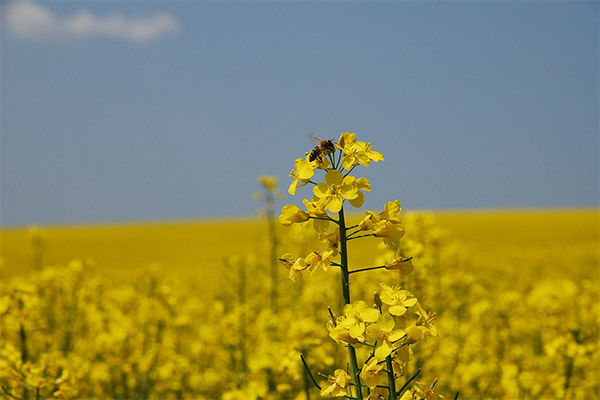
The first spring grass is especially dangerous: if you give it without restriction, then rabbits, bored for fresh greens during the winter, throw themselves and eat up so that their bellies swell, and this can be fatal. Colza is just one of the herbs that spring is one of the first, so animals are very eager for it. However, it is possible and necessary to feed colza with ears, especially after winter, because at such a time of the year it is a storehouse of vitamins. But do not give freshly cut grass, it must be wilted before distribution.
A little later, closer to mid-summer, when seeds were already tied up on the plants, colza is not suitable for feeding rabbits. Its seeds are poisonous.
The colza can be prepared for rabbits for the winter: dry in the shade and put in a hay barn.
Contraindications
Not everyone is treated with colza or eating it. First of all, this applies to people with poor blood coagulation. It is not recommended to get carried away with colitis for those who have kidney stones or urolithiasis, because flavonoids can provoke stone movement and even blockage of the ureters.
During pregnancy and breastfeeding, it is also not worthwhile to be treated with colza, since there is a threat of allergy.
For those whose organism for various reasons cannot assimilate different types of cabbage, one can expect a negative reaction to colza. It should also be noted that as a result of individual intolerance to the components of colza, an allergic rash may appear on the skin.
«Important: all information on the site is provided exclusively in fact-finding purposes. Before applying any recommendations, consult with a profile specialist. Neither the editors nor the authors are liable for any possible harm caused materials. "



